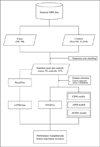Learning the impact of acute and chronic diseases on forecasting neonatal encephalopathy
- PMID: 34530389
- PMCID: PMC8551018
- DOI: 10.1016/j.cmpb.2021.106397
Learning the impact of acute and chronic diseases on forecasting neonatal encephalopathy
Abstract
Objective: There is a wide range of risk factors predisposing to the onset of neonatal encephalopathy (NE), including maternal antepartum/intrapartum comorbidities or events. However, few studies have investigated the difference in the impact of acute and chronic diseases on forecasting NE, which could assist clinicians in choosing the best course of action to prevent NE or reduce its severity and complications. In this study, we aimed to engineer features based on acute and chronic diseases and assess the differences of the impact of acute and chronic diseases on NE prediction using machine learning models.
Materials and methods: We used ten years of electronic health records of mothers from a large academic medical center to develop three types of features: chronic disease, recurrence of an acute disease, and temporal relationships between acute diseases. Two types of NE prediction models, based on acute and chronic diseases, respectively, were trained with feature selection. We further compared the prediction performance of the models with two state-of-the-art NE forecasting models. The machine learning models ranked the three types of engineered features based on their contributions to the NE prediction.
Results: The NE model trained on acute disease features showed significantly higher AUC than the model relying on chronic disease features (AUC difference: 0.161, p-value < 0.001). The NE model trained on both acute and chronic disease features achieved the highest average AUC (0.889), with a significant improvement over the best existing model (0.854) with p = 0.0129. Recurrence of "known or suspected fetal abnormality affecting management of mother (655)" was assigned the highest weights in predicting NE.
Conclusions: Machine learning models based on the three types of engineered features significantly improve NE prediction. Our results specifically suggest that acute disease-associated features play a more important role in predicting NE.
Keywords: Eletronic health records; Machine learning; Maternal medical history; Neonatal encephalopathy.
Copyright © 2021. Published by Elsevier B.V.
Conflict of interest statement
Declaration of Competing Interest The authors declare that they have no competing interests.
Figures
References
-
- Executive summary: Neonatal encephalopathy and neurologic outcome, second edition. Report of the American College of Obstetricians and Gynecologists’ Task Force on Neonatal Encephalopathy, Obstetrics and gynecology, 123 (2014) 896–901. - PubMed
-
- de Vries LS, Jongmans MJ, Long-term outcome after neonatal hypoxic-ischaemic encephalopathy, Arch Dis Child Fetal Neonatal Ed, 95 (2010) F220–224. - PubMed
-
- Kruse M, Michelsen SI, Flachs EM, Bronnum-Hansen H, Madsen M, Uldall P, Lifetime costs of cerebral palsy, Developmental medicine and child neurology, 51 (2009) 622–628. - PubMed
MeSH terms
Grants and funding
LinkOut - more resources
Full Text Sources
Medical





